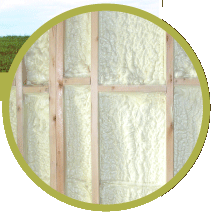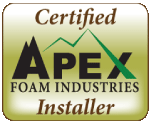Types of Foam:
Download This Page:

Foam Insulation: An Overview
Download our introduction to Spray Foram Insulation and Coatings

Types of Foam
This document explains the types of foam that we at Green Star spray.


Foam Insulation:
An Overview
Foam insulation has been used as a specialty product in the building industry for over 50 years. It is widely known to be a safer, more effective alternative to other insulators (e.g. fiberglass and cellulose). In recent years, technology has evolved to allow us to spray apply foam insulation at reasonable cost points. As architects and designers learn more about the product and its available characteristics, they will be amazed at the way it fills the needs involved in created energy efficient construction while maintaining excellent Indoor Air Quality, decreasing noise pollution and improving the overall indoor environment.
Foam insulation comes in endless varieties. At Green Star Foam, the four most common types we spray are: ½ lb., 1 lb, 2 lb, and 3 lb density foams. A ½ lb. foam that is fully cured and cut into a 1 cubic foot piece weighs ½ lb. That’s how it gets its name. The R-Value of foam is additive. So when we talk about a foam’s R-Value, we generally only mention the R-Value of the first inch. In other words, if a foam has an R-Value of 7, that foam applied two (2) inches thick has an R-Value of 14. Further, foam, unlike other insulators, expands to fill every possible gap or hole in the cavity to which it is applied. This makes all spray-applied foam an exceptional air barrier as well as an insulator. Other attributes available in different types of foams are: vapor barrier, structural capacity (commonly available up to 45 psi), waterproofing, self-flashing, fire and flame retardant (E 84), paintable, tintable, and sound-deadening.
top½ lb. Foam (LaPolla®)
(Spray- applied and Fill- applied)
The most well known type of “attic foam” is LaPolla® foam. LaPolla® is an open-celled ½ pound density foam. At Green Star Foam, we have historically sprayed numerous types of ½ pound foam. In doing so, we found LaPolla® to be the absolute best on the market. So, we have switched to spraying only LaPolla(R) 1/2 lb. foam. 1/2 lb. foam expands rapidly up to 150 times its initial volume and is dry to the touch within seconds. Spray applied LaPolla® ½ lb. foam expands rapidly up to 150 times its initial volume. It has an R-Value of 3.9 and uses water as a blowing agent, yet is dry to the touch within seconds. Of all foams available for insulation, ½ lb. is usually the most economical choose when the goal of maximum R-value is not limited by space or moisture issues.
There are two types of LaPolla® ½ lb. foam: spray-applied and fill-applied.
Spray-applied LaPolla® has an R-Value of 3.6 per inch of thickness. In other words, a 6-inch application of LaPolla® will provide a 21.6 R-value. Because LaPolla fills all cracks and crevices, it prevents air seepage in even the smallest areas. So, the effect of LaPolla® insulation is even greater than its stated R-value.
Fill-applied LaPolla® (also known as “pour fill”) has an R-Value of 4.0 per inch of thickness.The pour fill is an insulation and air barrier that injects the latest building technology into an older building to maximize energy efficiency while still preserving its original architectural details. Fill-applied LaPolla® fills the wall cavity completely, starting at the bottom and slowly expanding upwards to 60 times its initial volume. Since LaPolla expands in the direction of least resistance, it will not expand outward and damage the wall.
top1 lb. Foam
(Apex Platinum Series 1.0)
More recently, we have begun spraying a 1 lb. density foam. This foam is still technically labeled open cell foam, but it is truly a mix between the standard open cell ½ lb. foam and the 2 lb. closed cell foam. For it to be closed cell foam, the closed cell content would have to be at least 95% by volume.
The 1lb. foam is unique in that it has a delivered R-Value of at least 5. This means that one could spray 1 lb. foam in a 2 x 4 wall and achieve almost R-19 (5 x 4 =20) at a cost comparable to achieving R-19 with ½ lb. foam. It could be sprayed in a 2x6 constructions and still leave room for electricians to later fish wires through the walls. Or, one could make 2x6 walls almost an R-30.
top2 lb. foam
(numerous suppliers)
Closed Cell foam of a 2 lb density is unique both in its water resistant capacity and as a structural material. This means that as well as being an insulator and an air barrier, it is also a vapor barrier and a structural bracing material. Open celled foam (as mentioned above in the discussion on LaPolla® and the Apex Platinum Series 1.0) is an air barrier and an insulator, but has none of these other properties.
“Closed Cell” foam is also known as “wall foam” by many manufacturers. This is because, before the advent of the 1 lb foam, 2 lb foam was the only option in a 2 x 4 stud wall to achieve to Building Code accepted R-Values. 2 lb. foam made by different manufactures has a delivered R- Value of a range 6–7.5. In certain climates, it is still the only option that the doesn’t require a vapor barrier.
2 lb. foam is truly a magnificent material. We have used it to support floor joists and stop squeaking building members. We have also used it quite successfully in basements to prevent high humidity from the foundation and in attics when closing up ridge and soffit vents. If it weren’t for the cost, 2 lb foam would be the perfect solution to many building problems. However, 2 lb. foam is generally twice the cost per delivered R-Value as ½ foam, so most people use it only when the additional attributes of 2 lb. are necessary.
topRoofing Foam
When spray foam is used for roofing, a 3 lb. density closed cell foam is used. After the application of 3 lb. foam, a polyurea membrane is applied for protection. If you would like more info on this product, we’ll be happy to provide it. Different manufacturers’ foam vary widely so it is important to choose the proper foam for your particular project. We will gladly help you with this choice.






